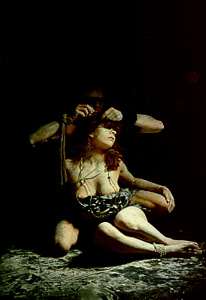Amazones et Afriques
Photographic exhibition

ARTWORKS

INTRODUCTION
When one speaks of nude photography, given the morality of the general public, one is automatically obliged to put up with complicit, allusive smirks which supposedly serve to underline one's membership in a sect of pornographers hidden behind the veil of the word "art".
I could add further that many "abstract" artists, considered in terms of their work and their message, state publically that those working with the representation of human beauty (i.e. nude) must necessarily have some slight "problem". One finds oneself thereby relegated to a community of the mentally disturbed just let loose by the new Article 180.
And then if one goes even further and speaks of erotic photography, one is immediately cast as defender of those obscene photographs in adult magazines that many of us leered at at an age when it was difficult, culturally, to imagine eroticism as a creative proposition of relations between the sexes who, after all, according to all religions, were divinely created. Here arises the difficulty in presenting a photography show which uses erotic images as its means of expression.
This does not seem the place to carry on about semantic differences such as the meaning of eroticism or pornography, nor is it fair to take advantage of the spectator's time throwing in facts to specify the variety of areas which utilize erotic images.
The only food for thought I would like to offer here regards the semantic origin of the word eroticism. I remember as a student when my classical lit. teacher called Eros that God on Olympus who was in charge of running relations between the sexes of the animal species through the highly erotic use of a bow and a few arrows.
Luckily erotic art still exists, and except for some chastity vows, mankind falls in love and reproduces, all thanks to that little pest who has amused himself for milennia shooting his arrows at human beings.
Therefore, if after having read these lines, you think the content of this exhibition might disturb your sense of decency, please stop here.
THE ARTIST AND HIS ARTWORK
Frederic Karikase was born in Burundi (Africa) in 1948 of a Burundi mother and a Belgian father - a classic adventurer who spent his life travelling around Africa, winning and losing fortunes in a variety of adventurous enterprises. The young Frederic, of European nationality, was in a Belgian hospital from the age of five for medical treatments which continued until the age of 18 when he returned to his native land, Africa, in search of his roots. Three years later, he went back to Belgium for medical reasons and except for a break of a single year, he spent the next 12 years living in the same hospital.
His youth was therefore marked by an intense rapport with suffering - his own and that of others. His long-term stay in the nursing home led him to form friendships with other patients in the wards - friendships based on the moment and on the impossibility of foreseeing or organizing a future. As he himself admitted, many of the closest relationships of his youth were lived out exclusively in that hospital environment, ending only when the friends were either discharged or died.
This singular experience in his formative years led Karikese to a profound analysis of the dynamic of pain and suffering - an analysis which is evident in all his work. In fact, his images are permeated with a subtle need to exorcise pain; they are a hymn to survival, to endurance and the need to be healed.
One should not be surprised, or ashamed, before Karikese' work if the first instinctive reaction be the Freudian desire to shut one's eyes, to run away from this human reality built on suffering and the impossibility of self-sufficiency. What Karikese shows is much more painful than images of an ethnic massacre; it is the portrayal of a systematic search for the strength to survive.
The works presented on this occassion are taken from a series particularly close to Frederic's heart - "mes amazones" and "mes afriques", portraying different aspects of the artist's creative life. On the one hand, he presents the idea of the fusion of the biological being with medical equipment designed to maintain one's vital functions, uniting their realities so fully that he manages to create some of the strangest cyborg creatures in the history of that genre. On the other hand, he presents us with his roots, expressing tribal dynamics straight from his African blood, but mixed with his reality as a citizen of Europe.
Frederic Karikese lives and works in Huy, a town near Liege in the French-speaking part of Belgium.
Leonardo Damiani
